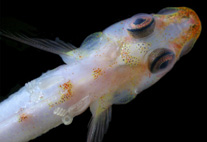Abstract
The parasitic copepod Creopelates floridus Shiino, 1958 (Siphonostomatoida: Pennellidae) is redescribed based on postmetamorphic adult females in the collection of the Imperial Majesty of Japan deposited in the National Museum of Nature and Science, Tsukuba (NSMT), Japan. Five new species of pennellid copepods are described based on postmetamorphic adult females from marine actinopterygian fishes newly collected in littoral waters of Japan and the Philippines, in the western North Pacific. The copepods and their hosts are as follows: Creopelates hosinoi n. sp. from Bryaninops yongei (Davis & Cohen) (Perciformes: Gobiidae); C. shirakawai n. sp. from Diancistrus fuscus (Fowler) (Ophidiiformes: Bythitidae); C. lubangenesis n. sp. from Gobiodon rivulatus (Rüppell) (Perciformes: Gobiidae); Nagasawanus akinohama n. gen. et n. sp. from Trimma grammistes (Tomiyama) (Perciformes: Gobiidae); N. snufkini n. gen. et n. sp. from T. tevegae Cohen & Davis. The total number of valid species contained in the genus Creopelates is now five. Nagasawanus n. gen. is distinguishable from other pennellid genera by the following features: antennary processes and cephalic lobes rounded without branched fringes, neck region without processes, maxilla with claw-like terminal segment lacking spinules. Keys to the genera of Pennellidae and to the species of Creopelates and Nagasawanus n. gen. are also provided.

